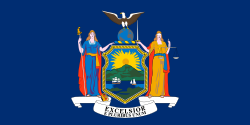| Speaker of the New York State Assembly | |
|---|---|
 Seal of New York | |
 Flag of New York | |
| Style | The Honorable (diplomatic) Mr. Speaker (within the assembly) |
| Inaugural holder | Walter Livingston September 10, 1777 |
| Formation | New York State Constitution |
| Succession | Third |
| Salary | $183,500 (2023) |
| Website | |
The Speaker of the New York State Assembly is the highest official in the New York State Assembly, customarily elected from the ranks of the majority party.
Contents
As in most countries with a British heritage, the Speaker presides over the lower house of the legislature. The position exists in every U.S. state and in the United States House of Representatives, the lower house of the Congress. New York's Assembly Speaker is very powerful, effectively, having the power to control much of the business in the Assembly and, in fact, throughout all of state government. Through almost single-handed control of the chamber, the Assembly Speaker is able to dictate what legislation makes and does not make it to the floor.
